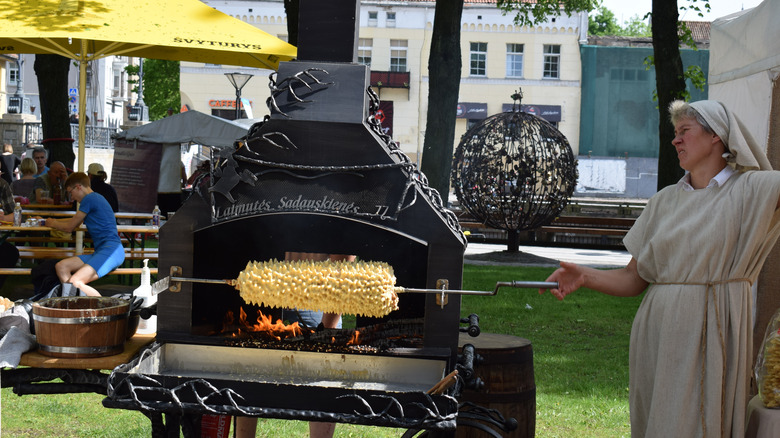This Is The Traditional Dessert Served At Lithuanian Weddings
One of the best parts of weddings is getting a glimpse of the stunning wedding cake. The confectionary showstoppers tend to tower in the reception space and are always eye-catching for the guests. While the cake might reflect the couple's unique interests or capture the room with its traditional pure white layers and intricate details in America, traditional wedding cakes in other countries can look quite a bit different.
Lithuanian weddings, for example, feature a tall pastry shaped like a Christmas tree as the traditional wedding cake. This tall cone-like structure goes by raguolis, which translates to "spiked" or sakotis, which means "branched," according to The Spruce Eats. But all of those names are rather apt for a cake with a cookie-like texture that heavily resembles an evergreen tree. Not to mention, this cake really does stand out considering its impressive height. They can range from 16 to 36 inches tall.
This cake is found in more countries than just Lithuania
You'll also find these types of cakes in Poland, Germany and even Hungary, where they are also served at notable events like holidays, such as Christmas and Easter (via The Spruce Eats). Apart from where and when this cake is served, the far more interesting details are all in how the tree cake is made. Using a batter made with a lot of eggs, the cake is made over a rotating spit to slow cook the cake. Essentially, the rod over the heat source is coated with batter before it is continually rotated as more batter is dripped onto the rod.
As the cake turns and batter is poured, the branches are formed as the batter builds up and drips down away from the rod. Once it's completely cooked and turned out onto a plate, the traditional tree cake is often decorated with flowers or fresh herbs at the very top of the dessert like a crown. Ultimately, the cake can be eaten plain or topped with fresh fruit or melted chocolate. So, if you find yourself in one of these countries around the holidays or even at a wedding, keep an eye out for the sakotis.

